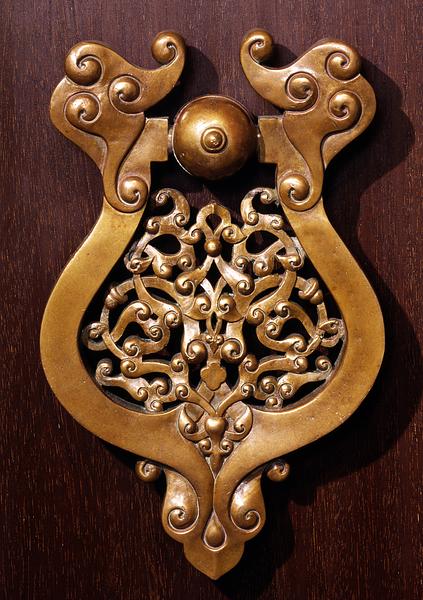Door knocker, cast and engraved bronze
Northern Iraq; 1st half of 13th century
H: 41.5; W: 25.5 cm
The central, very rich arabesque on this magnificent door knocker consists of characteristic palmettes with little curls. It lies on several levels and has different slants.
The ornamentation is closely related to the one found on a number of architectural decorations, woodcarvings, and metalwork from northern Iraq, for example on an astronomical table signed by Muhammad ibn Khutlukh al-Mawsili in 639 H = 1241-1242 in the British Museum. It must be considered a late derivative of the Samarra style, which had also been developed in Iraq some 400 years earlier. The powerful horseshoe-shaped frame might bring to mind stylized dragons – a well-known motif in Jazira.
Inv. no. 2/1993
Published in:
Kjeld von Folsach and Anne-Marie Keblow Bernsted: Woven Treasures: Textiles from the World of Islam, The David Collection, Copenhagen 1993, fig. 12, p. 53;
Kjeld von Folsach, Torben Lundbæk and Peder Mortensen (eds.): Sultan, Shah and Great Mughal: the history and culture of the Islamic world, The National Museum, Copenhagen 1996, cat. 71;
Kjeld von Folsach: Art from the World of Islam in The David Collection, Copenhagen 2001, cat. 505;
Sheila S. Blair and Jonathan M. Bloom (eds.): Cosmophilia. Islamic Art from the David Collection, Copenhagen, McMullen Museum of Art, Boston College, Boston 2006, cat. 82;
Persis Berlekamp: “Symmetry, sympathy, and sensation: talismanic efficacy and slippery iconographies in early thirteenth-century Iraq, Syria, and Anatolia” in Representations, 2016, 133, fig. 32, p. 102;
Corinne Mühlemann: Complex weaves: technique, text, and cultural history of striped silks, Affalterbach 2023, fig. 46, p. 83;
